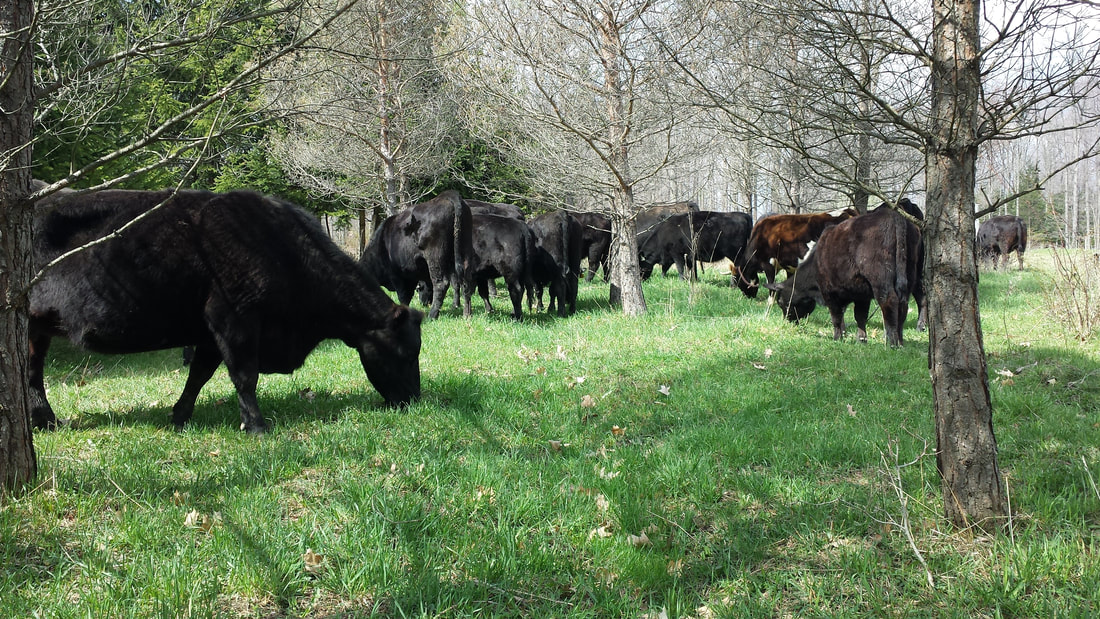 Cattle in a Silvopasture grazing system (13) Cattle in a Silvopasture grazing system (13) Current intensive livestock grazing practices have a significant negative effect on vegetation growth and diversity in various ecosystems throughout the world (1). Heavy grazing leads to a consistent decrease in the alpha diversity of plant groups; the number of distinct species in an area (2). Decreasing plant diversity contributes to the unprecedented loss of biodiversity we are currently seeing throughout the world, a significant issue encompassed by UN sustainability goal 15; Life on land (3). Intensive livestock grazing plays a key role in the degradation of fertile land, affecting the food security and ecosystem services of one billion people worldwide (4). Additionally, intensive livestock grazing releases stored soil carbon as carbon dioxide (5). Animal products provide all the essential amino acids as well as a dense store of proteins and fat required for human health (6). One billon people around the world rely on animal products for their survival (7). How do we balance these nutritional benefits and the demand they create with the undeniable impact livestock have on our planet? Regenerative agriculture may be the solution. Regenerative agriculture is described as “farming and grazing practices that….reverse…. reverse climate change by rebuilding soil organic matter and restoring degraded soil biodiversity…” (8). These practices have three main effects: Sequestering carbon from the atmosphere and locking it within the soil (8). Increasing the water storage capacity and percolation properties of soil which results in healthier and more sustainable groundwater catchments (8). Increasing biodiversity in the soil and on the surface (8). Central to the concept of regenerative agriculture are the processes of silvopasture, holistic planned grazing, and agroecology (8). These processes integrate grazing livestock with biodiverse landscapes comprising both trees and managed grasslands, mimicking how grazing herds used to migrate across major grasslands such as the American mid-west and the South African veld (9). Combining animals and crop systems may sound like a recipe for disaster, however, it has an excellent ecological basis following the hypothesis of intermediate disturbance. This states that achieving the highest levels of biodiversity in an ecosystem requires an intermediate intensity disturbance at an intermediate frequency for an intermediate period of time (10). This means that an ecosystem will function best when there is enough disturbance to create opportunities for new growth and the filling of niches, but not so much disturbance that the ecosystem is stripped of its life completely. In the South African veld this is achieved through maintaining dense herds of cattle that are moving constantly, mimicking the migration of large grazing herds in the area, thus maintaining the ecosystem (9). Here in New Zealand, where almost 50% of our emissions come from the agricultural sector (11), regenerative agriculture may provide the solution we have been looking for. Already a movement has begun lead by Mangarara station in the Hawkes Bay who have turned their farm into a biodiverse landscape whilst still running sheep, cattle and poultry (12). If we can learn from nature and follow the example set by places such as Mangarara station then the future of New Zealand’s, and the World’s, food security and ecosystem integrity can be secured. References 1. Impacts of livestock grazing on plant species composition in montane forests on the northern slope of Mt. Kilimanjaro, Tanzania. Kikoti, Imani A. and Mligo, Cosmas. 2, s.l. : International journal of biodiversity science, ecosystem services and management, 2015, Vol. 11, pp. 114-127. 2. The impact of livestock grazing on plant diversity: An analysis across dryland ecosystems and scales in southern Africa. Hanke, Wiebke, et al. 5, s.l. : Ecological applications, 2014, Vol. 24, pp. 1188-1203. 3. United Nations. Biodiversity. Sustainable development goals. [Online] [Cited: 03 09, 2020.] https://www.un.org/sustainabledevelopment/biodiversity/. 4. —. E Infographic 15. Sustainable development goals. [Online] [Cited: 03 09, 2020.] https://www.un.org/sustainabledevelopment/wp-content/uploads/2019/07/E_Infographic_15.pdf. 5. Rosales, Mauricio and Livinets, Svetlana. Grazing and land degradation in CIS countries and Mongolia. Viale delle Terme di Caracalla : Food and agriculture organisation. 6. Beyond milk, meat, and eggs: Role of livestock in food and nutrition security. Smith, Jimmy, et al. 1, s.l. : Animal Frontiers, 2013, Vol. 3, pp. 6-13. 7. Regeneration International. Holistic planned grazing. Regeneratio International. [Online] [Cited: 03 10, 2020.] https://regenerationinternational.org/tag/holistic-planned-grazing/. 8. Regeneration International. Why regenerative agriculture. Regeneration International. [Online] [Cited: 03 10, 2020.] http://2igmzc48tf4q88z3o24qjfl8.wpengine.netdna-cdn.com/wp-content/uploads/2017/02/Regen-Ag-Definition-2.23.17-1.pdf. 9. Mckenzie, David and Swails, Brent. Put down that veggie burger. These farmers say their cows can solve the climate crisis. CNN. [Online] CNN. [Cited: 03 10, 2020.] https://edition.cnn.com/2020/03/06/africa/agriculture-regenerative-farming-climate-crisis-intl/index.html. 10. Biodiversity and disturbance. Willig, M R and Presley, S J. 1, s.l. : Encyclopedia of the anthropocene, 2018, Vol. 3, pp. 45-51. 11. Ministry for the Environment. Environment Aotearoa 2019. s.l. : Ministry for the Environment, 2019. p. 94. 12. Hart, Greg and Hart, Rachel. Mangarara station - home. Mangarara station. [Online] [Cited: 03 11, 2020.] https://www.mangarara.co.nz/. 13. Smallidge, Peter. Silvopasture development: Trees into pasture. CornellForestConnect. [Online] [Cited: 03 15, 2020.] http://cornellforestconnect.ning.com/profiles/blogs/silvopasture-development-trees-into-pasture.
1 Comment
|
Details
AuthorAs a local New Zealand family owned and operated business we are proud ensure D.I.Y is kept in our DNA as can be seen when walking through the Gardens, Nursery and Garden Center. Never ones to let a hard tasks pass us by we tackle them head on and learn as much as we can as fast as we can to try and create a positive change and encourage people to fall in love with the outdoors again. Archives
November 2023
Categories |
1747 SH2, Upper Hutt, Wellington - 027 716 8186 - nursery@astonnorwood.co.nz - Open 7 days

 RSS Feed
RSS Feed